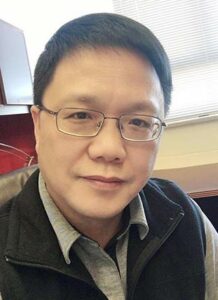May 05, 2020

Hao Sun
A Mizzou Engineering graduate student has been invited to share his work at a prestigious conference after devising a way for robots to learn human intention and anticipate their behaviors.
Hao Sun will participate in the Computer Vision and Pattern Recognition (CVPR) Conference hosted by the Institute of Electrical and Electronics Engineers (IEEE) in June. It’s the largest Artificial Intelligence (AI) conference of its kind, and this year’s headliners include the CEO of Microsoft and a senior vice president from Amazon. More than 10,000 people submitted papers to the conference, and Sun is one of fewer than 5% invited to give an oral presentation.
“It’s quite a success and an exciting opportunity for Hao,” his advisor, Henry He, said. “This will help him promote his important work.”
Sun’s research builds upon current models that allow artificial intelligence to navigate by predicting the way people will behave in the immediate future.
But rather than just looking at what’s to come, Sun has developed with a way that allows AI to base future predictions on what has just occurred.
“AI can automatically learn something like rules or patterns from data we provide,” Sun said. “When AI knows the trajectory of a person a few seconds ago, it can predict where that person will go in the next few seconds based on what it has learned.”
For example, if two self-driving cars are driving toward each other, they would be able to predict a potential collision based on observations of past trajectories, allowing them to send a signal for help.
Sun’s algorithm also uses future trajectories to log the accuracy of those previous predictions.

Henry He
“There are two prediction modules: Forward predictions from the past to predict the future, then backwards predictions to the past from the future,” He said.
Equipping AI with this human reasoning and response system could improve the way technology interacts with human. In addition to improving the capability of self-driving cars, this research could lead to robots that are better equipped to assist humans.
“Applying this to smart manufacturing, robots and human workers could work better together,” He said. “Robots cannot be passive. To help a worker, you need to anticipate what the worker will do next. This could allow robots to collaborate with humans better and much more efficiently—doing tasks such as handing over the right tool or knowing when to get out of the way.”
Sun credits He for helping him work through the research project over the past year and prepare the technical paper for submission, and his fellow graduate students for their collaboration.
“My lab mates and I discuss this topic and other projects over lunch and during break times in the lab, and that has also helped me a lot,” he said.
Sun, who is earning a PhD in electrical engineering, plans to defend his dissertation this summer and hopes to work for a large technology company.
Right now, however, he’s excited to share his work at the CVPR conference, which he attended last year in California.
This year’s event was slated to be held in Seattle and draw more than 10,000 professionals and students from across the globe. Most of the program has now been converted to a virtual format, but is still expected to attract thousands of attendees online.
“I’ll be making a 5-minute video presentation, and I believe it will reach many people,” Sun said. “It’s a very big deal.”